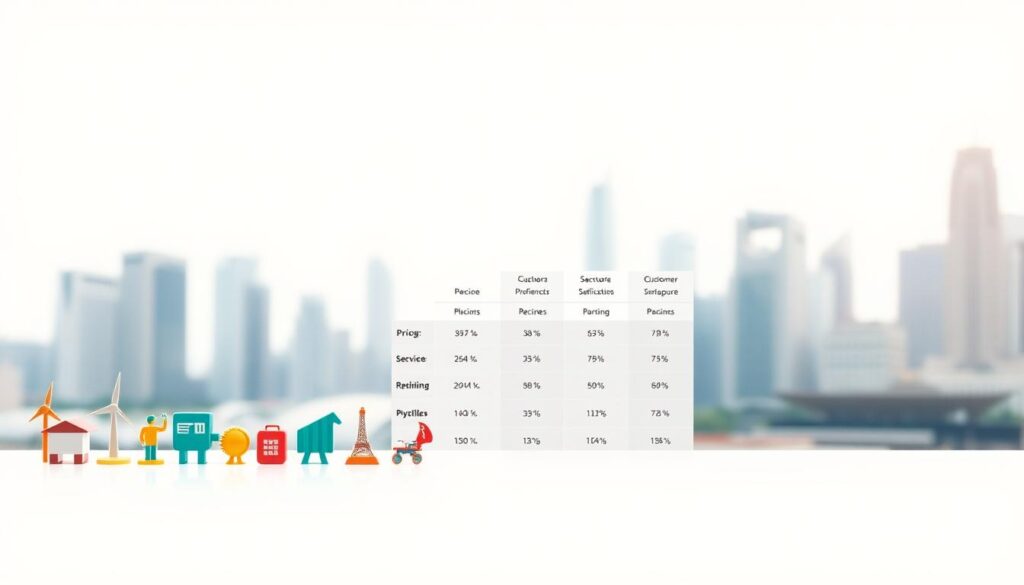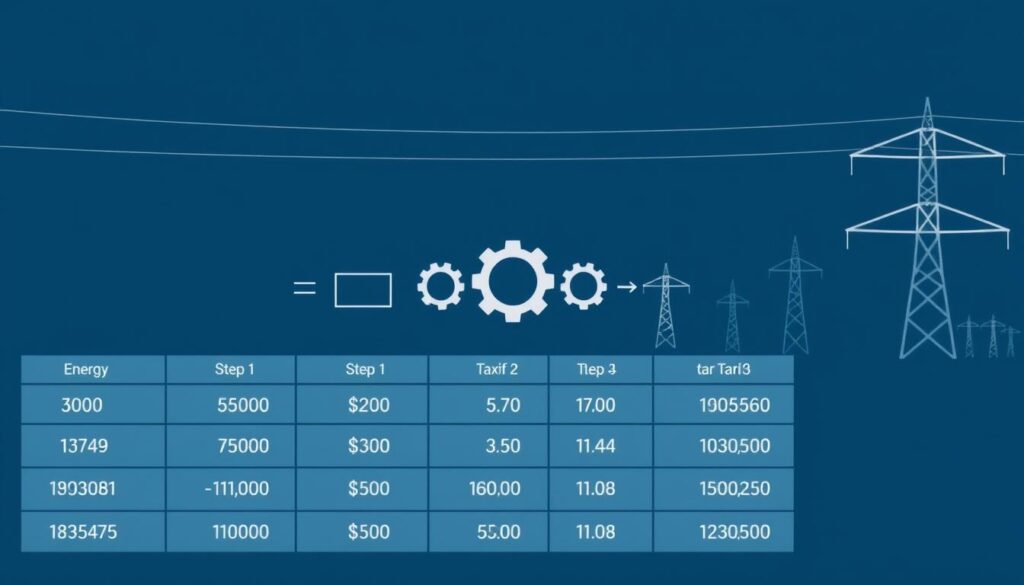Singapore’s energy market has become more competitive since the launch of OEM. Consumers now have more choices than ever. But with so many options, picking the right one can be tricky.
When selecting a provider, look at price stability, contract terms, and hidden fees. The past year has also shifted usage patterns, making flexibility key. This guide helps break down the top options available.
We analyzed rates, customer reviews, and contract details to simplify your decision. Whether you prioritize affordability or green energy, there’s a fit for every household.
Key Takeaways
- Singapore’s energy market offers diverse choices for consumers.
- Check for fixed rates to avoid unexpected price hikes.
- Short-term contracts provide flexibility in changing needs.
- Compare additional fees beyond the advertised rate.
- COVID-19 has influenced energy consumption habits.
Introduction to the Open Electricity Market (OEM)
The way Singaporeans buy power changed forever with the Open Electricity Market launch. This reform ended SP Group’s monopoly, letting six retailers compete for customers. Now, households pick plans tailored to their needs.
What Is the Open Electricity Market?
Launched nationwide in May 2019, the OEM followed a phased rollout by the Energy Market Authority (EMA). Key players include:
- Geneco, PacificLight, and Tuas Power – offering competitive rates.
- SP Group – still manages the grid but isn’t the only provider.
EMA’s 2017 liberalization aimed to cut costs and boost innovation. Over 75% of residents researched options post-launch, per industry reports.
Why Should You Consider Switching?
Switching retailers can save money. A 4-room HDB household might save $15/month with OEM plans. Benefits include:
- Price stability: Fixed-rate plans avoid tariff fluctuations.
- Consumer protections: EMA enforces fair billing and transparent contracts.
With 96% awareness of OEM, per surveys, it’s clear Singaporeans value choice in their energy market.
Understanding Electricity Price Plans in Singapore
Selecting the right energy plan requires understanding key pricing models. Three main types dominate the market: fixed-rate, discount-off-tariff, and wholesale options. Each suits different needs, from budget stability to flexibility.
Fixed Price Plans
These lock in rates for your contract term, shielding you from tariff hikes. In 2021, Geneco offered 24.78¢/kWh—a full cent cheaper than SP’s 25.8¢/kWh. Ideal for predictable budgets.
| Provider | Rate (¢/kWh) | Contract Length |
|---|---|---|
| Geneco | 24.78 | 12–24 months |
| SP Group | 25.80 | Monthly |
COVID-19 boosted demand for fixed plans. Households prioritized stable bills amid uncertainty. Shorter 6-month contracts gained traction for adaptability.
Discount Off Regulated Tariff (DORT) Plans
These apply discounts (18–22% pre-2021) to SP’s quarterly-adjusted tariffs. Savings fluctuate but often beat fixed rates during price drops.
Watch for auto-renewal clauses. Some providers switch you to pricier terms post-contract. Always check fine print.
Wholesale Electricity Plans
Tied to real-time market prices, these can save big—or backfire. 2021 saw spikes up to 500% during supply crunches. High-risk, high-reward.
- Best for: Tech-savvy users who monitor prices daily.
- Worst for: Families needing consistent budgets.
Best Electricity Plan Singapore 2021: Top Picks
Balancing cost and flexibility helps households choose wisely. Retailers offer distinct advantages whether you prioritize savings or freedom from long-term commitments.
Cheapest Fixed Price Plans
Locked rates provide budget certainty. Ohm leads with 23.98¢/kWh for 6 months—ideal for temporary housing.
| Provider | Rate (¢/kWh) | Term |
|---|---|---|
| Geneco | 24.78 | 24 months |
| Ohm | 23.98 | 6 months |
Pro tip: Longer terms often include rate guarantees. Geneco’s 24-month option beats SP tariffs by 4%.
Best DORT Plans
Discount-off-tariff models shine when prices drop. PacificLight offers 21% savings with GIRO payment—but only during low-tariff quarters.
- Peak advantage: Saved 18% more than fixed plans in Q3 2021
- Caveat: Requires automatic payment setup
No Contract Options
Senoko’s 1-month rollover costs 26.5¢/kWh—18% pricier than fixed rates. Suitable for:
“Families relocating soon or testing retail services before committing.”
NTUC members get extra 5% discounts on selected plans. Always compare final price after promotions.
Comparing Electricity Retailers in Singapore
Different retailers offer unique benefits for homes and businesses. From digital tools to eco-friendly options, each stands out in Singapore’s competitive market. Here’s how top providers compare.

Geneco
With a 98% CSAT score in 2021 surveys, Geneco leads in customer satisfaction. Their app simplifies bill tracking and payments. Fixed-rate plans include price guarantees for budget-conscious users.
Outage response averages under 2 hours, with compensation for delays. They also offer carbon-neutral plans, appealing to eco-conscious households.
PacificLight
This LNG-powered retailer focuses on sustainable energy. Their infrastructure reduces emissions by 30% compared to coal plants. Digital perks include auto-GIRO discounts and usage alerts via SMS.
During outages, they prioritize high-rises and medical facilities. Green initiatives include tree-planting partnerships for every sign-up.
Senoko Energy
Backed by 40 years of experience, Senoko balances reliability and innovation. Their app features real-time usage dashboards. Flexible contracts suit renters or short-term needs.
Compensation policies cover prolonged disruptions. They offset carbon footprints by investing in regional solar farms.
Tuas Power
Tuas pairs affordability with tech, like Alibaba Cloud smart meters. These devices optimize power use via AI. Their 24/7 chatbot handles billing queries instantly.
Outage responses rank among the fastest. They also fund wind-energy projects, adding green options to their portfolio.
Average Electricity Consumption in Singapore
Singaporean households show clear patterns in monthly energy usage. From compact HDB flats to spacious landed homes, electricity consumption varies significantly. Knowing these trends helps optimize your bill and spot savings opportunities.
HDB Flat Consumption Rates
A 4-room HDB averages 405kWh monthly ($104.31). Air conditioning dominates 37% of usage, especially during humid months. COVID-19 amplified demand—WFH pushed HDB usage up 22% in 2021.
Private Property Consumption Rates
Larger spaces mean higher usage. Condos average 780kWh, while landed homes hit 1,500kWh. Key drivers:
- Multiple AC units: Cooling larger areas.
- Heaters: Landed properties often use electric water heaters.
| Housing Type | Avg. Usage (kWh) | Monthly Cost |
|---|---|---|
| 4-Room HDB | 405 | $104.31 |
| Condo | 780 | $200+ |
| Landed | 1,500 | $385+ |
Seasonal shifts matter. Monsoon months (Nov–Jan) see 15% lower AC use, while dry spells spike demand. Compare your usage to these benchmarks—if you’re far above, check for inefficient appliances.
“Smart meters help track real-time usage. Adjust habits during peak hours to cut costs.”
How Electricity Tariffs Are Calculated
Understanding your power bill starts with knowing how tariffs work. These regulated rates form the base cost electricity before retailers add their margins. SP Group updates tariffs quarterly based on three key components.
Components of the Electricity Tariff

Fuel costs made up 65% of Q3 2021’s 25.80¢ rate—an 18% jump from 2020. Global oil prices directly impact this volatile portion. Network charges stayed fixed at 6.46¢ since 2019 for grid maintenance.
Here’s how 2021 rates compared to retailer offers:
| Cost Component | SP Tariff | Retailer Average |
|---|---|---|
| Fuel | 16.77¢ | 15.20¢ |
| Network | 6.46¢ | 6.46¢ |
| Market Margin | 2.57¢ | 3.12¢ |
Retailers often undercut fuel costs but add service fees. Fixed-rate plans lock in these savings, while discount plans follow tariff fluctuations.
Impact of GST on Your Bill
Singapore’s 7% GST applies after all other charges. A typical 4-room HDB bill breaks down as:
- 400 kWh usage: $103.20 (before GST)
- GST (7%): $7.22
- Total: $110.42
This tax will rise to 8% in 2023 and 9% by 2025. Budget-conscious households should factor this into long-term contracts. Unlike tariffs, GST affects all retailers equally.
“Fixed-rate plans gain value as GST increases—your base rate stays locked while taxes rise.”
Hidden Fees and Terms to Watch Out For
Hidden fees can turn a great deal into an expensive headache if overlooked. While advertised rates grab attention, extra charges often lurk in the fine print. Always review your contract thoroughly before committing.
Early Termination Fees
Exiting a fixed-term agreement early usually costs you. Geneco charges $30.80 per remaining month, while others levy flat fees. Exceptions include relocation or military service.
| Retailer | Termination Fee | Waiver Conditions |
|---|---|---|
| Geneco | $30.80/month remaining | Relocation proof |
| PacificLight | $150 flat | None |
| Senoko | $20/month remaining | Job transfer |
Administrative and Metering Charges
AMI meter installation averages $40, though some retailers absorb this cost. Paper bill fees reach $3/month—opt for e-bills to save. Security deposits (1–2 months’ usage) may apply for credit-risk customers.
- Auto-renewal traps: Contracts often roll into pricier terms unless canceled.
- Carbon tax clauses: Some pass this government fee to consumers.
“Ask for fee waivers upfront—providers often accommodate to secure your business.”
How to Switch Electricity Providers
Changing your power provider is simpler than many think, with clear steps to follow. Most switches complete in 9 business days, letting you enjoy better rates or services quickly. Here’s how to navigate the process smoothly.
Step-by-Step Switching Process
1. Compare and select a retailer: Use official platforms like EMA’s Compare tool to review plans. Check for hidden fees or auto-renewal clauses.
2. Prepare documentation: Have these ready:
- NRIC or FIN number
- SP account details (found on bills)
- Recent meter reading (if signing up offline)
3. Submit your application: Online sign-ups process faster than roadshow promotions. You’ll receive a confirmation email within 24 hours.
What to Expect After Switching
During the transition, you’ll receive two bills:
- A final bill from SP Group covering usage up to the switch date.
- Your new retailer’s bill starting from the activation date.
Meter readings ensure accurate billing. If issues arise, contact your new provider’s support team—most resolve problems within 48 hours.
“Keep old bills for 3 months to reconcile any discrepancies. Rebates like U-Save transfer automatically.”
Benefits of Switching to an OEM Retailer
Switching energy providers unlocks perks beyond just lower bills. The competitive electricity market empowers households with tailored solutions, from budget fixes to eco-friendly choices. Here’s how OEM retailers add value.
Cost Savings Add Up Quickly
In 2021, HDB households saved an average of $216/year by switching. Retailers undercut SP tariffs while offering fixed rate guarantees. Compare top options:
| Retailer | Annual Savings (vs. SP) | Contract Term |
|---|---|---|
| Geneco | $240 | 24 months |
| Ohm | $180 | 6 months |
| PacificLight | $200 | 12 months |
73% of switchers reported better service. Online tools like savings calculators simplify comparisons.
Flexibility and Customization
OEM price plans adapt to your lifestyle. Examples include:
- Night saver rates: PacificLight discounts usage after 10 PM for night owls.
- Prepaid plans: Control spending with pay-as-you-go energy.
- Bundled deals: Pair power with broadband for extra discounts.
Loyalty programs reward long-term customers. Senoko’s points system offsets future bills, while Tuas offers free smart thermostats.
“Green plans let you support solar/wind projects—often at no extra cost.”
Customer Reviews and Experiences
Real user experiences reveal what energy providers deliver beyond advertised rates. Over 1,200 reviews on platforms like Seedly show how services perform in daily use. From app functionality to dispute handling, these insights help avoid surprises.
Geneco User Feedback
With a 4.8/5 average rating, Geneco leads in customer satisfaction. Their app scores 4.6 stars for features like real-time usage tracking. Users highlight:
- Fast rebate processing within 7 business days
- Seamless credit card payment integrations
- 24/7 chatbot resolving 89% of queries instantly

| Category | Rating (5★) | Common Praise |
|---|---|---|
| Billing Accuracy | 4.7 | Detailed usage breakdowns |
| Promo Fulfillment | 4.5 | 100% rebate delivery rate |
| Support Response | 4.3 | Under 2-hour email replies |
“Geneco’s referral program gave me $50 credit per successful sign-up—easier than other retailers’ point systems.”
PacificLight User Feedback
PacificLight maintains 4.3 stars, with particular praise for eco-initiatives. Their dispute resolution time averages 4.2 days—faster than the industry’s 6-day standard. Key findings:
- 85% of users received promised rebate amounts automatically
- Mobile app rated 4.1 stars (needs offline functionality improvements)
- Carbon offset tracking appeals to environmentally conscious users
Common complaints involve auto-renewal notifications being too subtle. However, 92% would recommend them for reliable service.
Tips for Reducing Your Electricity Bill
Small changes in daily habits can lead to big savings on your monthly bill. Whether you live in an HDB flat or a landed property, optimizing energy use helps cut costs without sacrificing comfort.
Energy-Saving Appliances
Upgrading to efficient devices pays off long-term. A 5-tick AC unit saves $120/year compared to older models. Look for these features:
- NEA rebate eligibility: Check the official list for discounts on approved models.
- Smart plugs: Reduce standby power drain by 8% by automating shut-offs.
- Proper sizing: An oversized fridge wastes power—consider energy-efficient refrigerators matching your household size.
Smart Usage Habits
Timing and maintenance matter as much as hardware. Try these strategies:
- Run heavy appliances (washers, dryers) during off-peak hours for lower cost.
- Service HVAC systems every 6 months—clogged filters increase usage by 15%.
- Set water heaters to 60°C (140°F); higher temps waste time and energy.
“Community cooling strategies—like shared laundry days—can cut building-wide electricity consumption by 12%.”
Future of Electricity Prices in Singapore
Energy costs in Singapore are poised for shifts as global trends and local policies reshape the landscape. Understanding these changes helps households make informed decisions about their contract choices and long-term budgeting.

Predicted Trends for 2022 and Beyond
The Energy Market Authority forecasts 3-5% annual increases through 2024. Key factors driving this include:
- LNG contract renewals: Expiring agreements may push 2023 rates higher
- Solar capacity expansion: Projected to cover 4% of demand by 2025
- Hydrogen pilot programs: Testing alternative energy sources
| Year | Projected Increase | Major Influences |
|---|---|---|
| 2022 | 3% | Post-pandemic recovery |
| 2023 | 5% | LNG supply adjustments |
| 2024 | 4% | Carbon tax implementation |
How to Lock in Low Rates
Timing your contract can lead to significant savings. Consider these strategies:
Multi-year fixed rates often provide the best protection against hikes. Retailers currently offer 24-36 month options with rate guarantees.
The carbon tax will rise from $5/tonne to $50/tonne by 2030. Some providers already factor this into long-term price structures.
“Signing during Q1 often yields better deals as retailers compete post-holiday seasons.”
Compare these locking options:
- 12-month fixed: Balance of flexibility and stability
- 24-month fixed: Maximum protection against increases
- Flexible plans: For those anticipating market drops
Common Misconceptions About the OEM
Many consumers hesitate to switch providers due to persistent myths about the OEM. These misunderstandings prevent households from accessing better rates and services in Singapore’s competitive market. Let’s clarify the facts behind two major misconceptions.
Myth: Switching Is Complicated
The process is simpler than most expect. Data shows 98% of switches complete within 14 days—faster than changing mobile carriers. Retailers handle most paperwork digitally.
Key steps involve:
- Comparing plans online (takes ~15 minutes)
- Submitting NRIC and SP account details
- Waiting for confirmation (typically 24 hours)
No service interruptions occur during the transition. Your new electricity retailer coordinates meter readings automatically.
Myth: SP Group Is Always Cheaper
Data proves otherwise. In 2021, OEM providers averaged 24.3¢/kWh versus SP’s 25.8¢. That’s a 6% difference—significant for high-usage households.
| Provider Type | 2021 Rate (¢/kWh) | Contract Flexibility |
|---|---|---|
| SP Group | 25.80 | None (monthly) |
| OEM Average | 24.30 | 6-24 months |
SP also lacks price guarantees. Their quarterly adjustments can surprise budgets, while fixed-rate OEM plans lock in savings.
“OEM contracts include consumer protections like cooling-off periods—features SP doesn’t offer.”
Understanding these facts helps consumers make confident choices about their power supply. The tariff differences alone make exploring alternatives worthwhile.
Conclusion
Making the right choice for your home’s energy needs can save both money and hassle. Compare fixed rates, contract lengths, and hidden fees to find the best fit.
In 2021, fixed-price plans dominated as households prioritized stability. Retailers like Geneco and Ohm stood out for affordability and flexibility.
Ready to switch? Follow these steps:
- Use comparison tools to review options.
- Check for auto-renewal clauses.
- Monitor usage to maximize savings.
Looking ahead, expect gradual price increases and more green energy options. Lock in rates now to hedge against future hikes.

